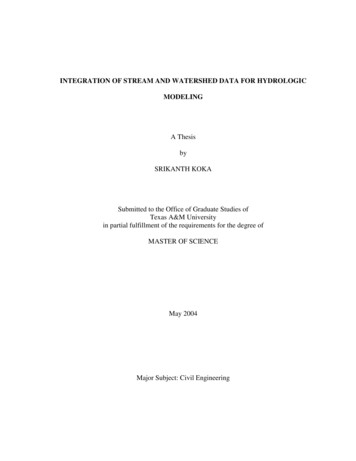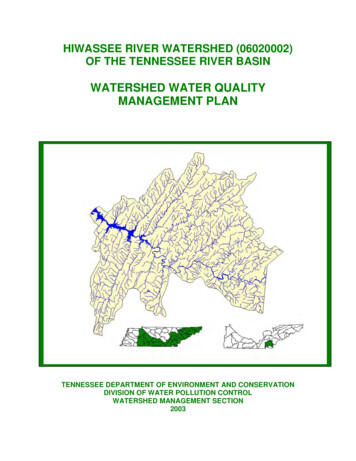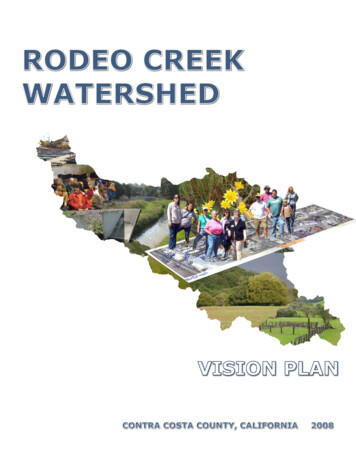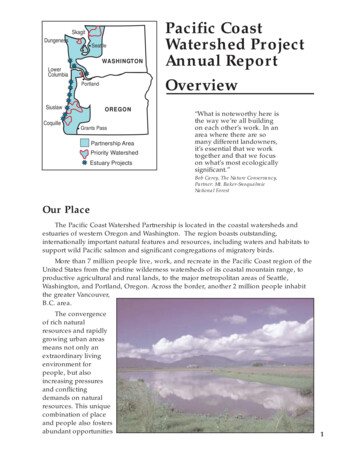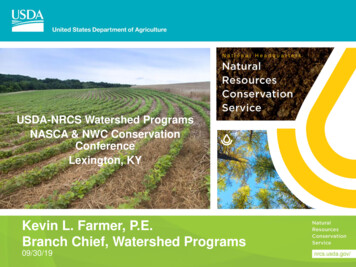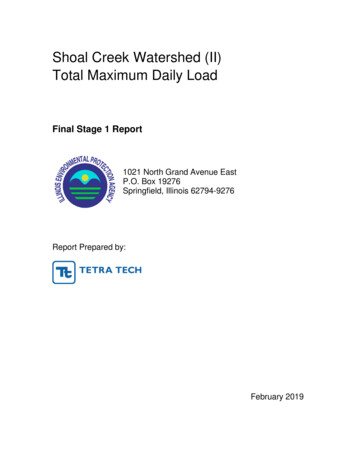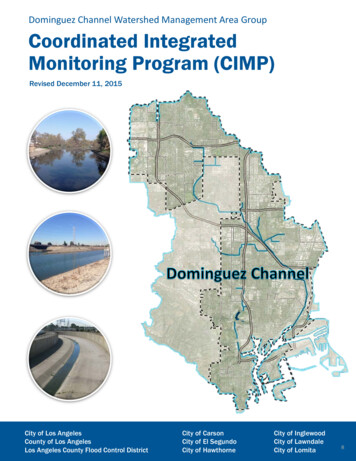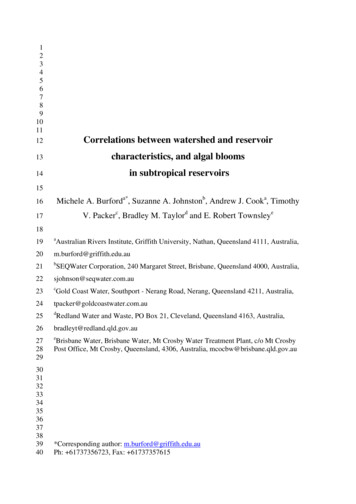
Transcription
123456789101112Correlations between watershed and reservoir13characteristics, and algal blooms14in subtropical reservoirs1516Michele A. Burforda*, Suzanne A. Johnstonb, Andrew J. Cooka, Timothy17V. Packerc, Bradley M. Taylord and E. Robert m.au25dAustralian Rivers Institute, Griffith University, Nathan, Queensland 4111, Australia,SEQWater Corporation, 240 Margaret Street, Brisbane, Queensland 4000, Australia,Gold Coast Water, Southport - Nerang Road, Nerang, Queensland 4211, Australia,Redland Water and Waste, PO Box 21, Cleveland, Queensland 4163, 323334353637383940Brisbane Water, Brisbane Water, Mt Crosby Water Treatment Plant, c/o Mt CrosbyPost Office, Mt Crosby, Queensland, 4306, Australia, mcocbw@brisbane.qld.gov.au*Corresponding author: m.burford@griffith.edu.auPh: 61737356723, Fax: 61737357615
21Abstract2This study examined the correlations between watershed and reservoir characteristics,3and water quality parameters related to algal blooms in seven subtropical reservoirs.4Analysis of the dissimilarity of physico-chemical parameters resulted in separation of5the reservoirs into three main groups: four reservoirs with the highest proportion of6agriculture and/or urban land use in their watersheds; two reservoirs with a high7proportion of forest cover; and one small reservoir with a relatively pristine watershed8was intermediate between the other two groups. All reservoirs were dominated by9cyanobacteria, and at times, had species capable of producing toxins. However, the10three reservoirs with the lowest percentage forest cover ( 50%) had the highest11frequency and magnitude of toxic species, principally Cylindrospermopsis12raciborskii. Analysis of dissimilarity of algal species composition resulted in three13reservoir groups similar to that for the physico-chemical parameters, with the14exception of the reservoir with the highest percentage urban land use being an outlier.15Across all reservoirs, percentage forest cover in the watershed, watershed area and16reservoir volume were all significantly correlated with algal cell concentrations and17total nitrogen (TN), but not with chlorophyll a concentrations. Total phosphorus (TP)18was only correlated with the proportion forest cover in the watershed, suggesting that19reservoir volume and depth were of less importance for TP than for algal cell20concentrations or TN. These results suggest that watershed pattern and reservoir21characteristics, such as water volume and depth, have a measurable effect on the type22of algal blooms in reservoirs.2324Keywords25Cyanobacteria, nutrients, reservoir, algal species, watershed
312Introduction3Maintenance of water quality in drinking water reservoirs within required guidelines4is a key issue for reservoir managers. Considerable resources are allocated to monitor5water quality and trigger responses when water quality deteriorates. This ensures that6human and environmental health is not compromised and that treatment plants are not7challenged beyond their capabilities. One of the key water quality parameters of8concern is cyanobacterial blooms. Depending on the dominant species, blooms may9create low oxygen conditions, taste and odour problems, or produce toxins harmful to10humans and animals (Oliver and Ganf 2000)1112Anthropogenic modification of reservoir watersheds, such as agriculture, increases13nutrient and suspended solids inputs during inflow events. Broadscale cropping or14grazing can encompass a large proportion of the watershed and there is evidence of15increased nutrients and suspended solids in receiving waters as a result (Ulrich 1997;16Harris 2001; Knoll et al. 2003). A study of American water suppliers found that 50 to1755% of the variation in treatment costs for reservoir water can be explained by the18percentage natural vegetation i.e. forest cover in the watershed. More specifically19they found that with every 10% increase in forest cover (up to 60% cover), water20treatment costs were reduced by approximately 20% (Ernst 2004).2122However, watershed inputs, particularly nutrients, are not the only driver of algal23growth. Reservoirs have created an artificial environment conducive to algal growth,24and particularly cyanobacteria, with calm waters, low light attenuation and a relatively25long residence time. Additionally reservoirs can be a trap for watershed nutrients,
41which may be processed into more bioavailable forms in the water column and2sediment prior to utilization by algae within the system. The longer the residence3time, and the more anoxic the bottom waters, the more likely this is to happen. In4subtropical and tropical regions this problem is exacerbated by warm summers5stimulating rapid algal growth, peaks in nutrient inputs from large inflow events, and6infrequent flushing (Jones and Poplawski 1998). Therefore factors such as residence7time, light availability, mixing, and water depth can be expected to affect algal8growth.910This study involved an inter-reservoir comparison of both reservoir and watershed11characteristics that may be promoting algal blooms in subtropical reservoirs.1213Materials and Methods14The study involved seven drinking water reservoirs in subtropical southeast15Queensland, Australia (Fig. 1). The full supply volumes ranged from 9,280 to161,165,000 ML with watershed areas ranging from 5,600 to 571,000 ha (Table 1).17Leslie Harrison reservoir was the shallowest with a mean depth of 5.3 m while Hinze18reservoir was the deepest, 17.8 m. The water residence time, in years, was calculated19as the total volume divided by the mean yearly water release volumes. Data was not20available for Manchester reservoir. North Pine and Manchester reservoirs had a21destratification unit operating throughout the period of the study (Antenucci et al.,222005; Burford & O’Donohue 2006).2324Manchester reservoir had the most pristine watershed with close to 100% forest (Fig.252). The other extreme was Wivenhoe Reservoir which had approximately 50%
51agricultural land, much of this being used for cattle grazing. Leslie Harrison2Reservoir had the highest proportion of urban land, although most of this was low-3density rural properties.45The study involved sampling on 4 occasions (4-8 October 2004, 13-17 December62004, 7-11 February 2005, 11-15 April 2005). All seven reservoirs (Leslie Harrison7(LH), Little Nerang (LN), Hinze (HZ), North Pine (NPD), Somerset (SOM),8Wivenhoe (WIV), Manchester (MAN)) were sampled on each occasion. The same9sampling equipment and protocol was used throughout the study. Two sites were10sampled in each reservoir, one near the reservoir wall, the other upstream near the11inflow from the largest river. The upstream site was approximately 1 km upstream in12the case of Manchester, Leslie Harrison and Little Nerang reservoirs, while Hinze13was 2 km, North Pine and Somerset were 5 to 6 km and Wivenhoe was 12 km.14Surface water was sampled at each site using a PVC pipe to obtain a top 3 m depth-15integrated sample. Water was then poured into a clean bucket. Bottom water (a few16metres from the bottom) was sampled at each site using a van Dorn sampler and17poured into a clean bucket.1819Replicate subsamples from the surface and bottom at each site were taken from the20buckets for TN and TP analysis and stored on ice until frozen in the laboratory.21Replicate subsamples for chlorophyll a analysis (surface and bottom) were also taken22by filtering known volumes of water into GF/F glass fibre filters, and storing the23filters on ice until frozen in the laboratory. Surface (only) subsamples were taken for24total algal counts, and taste and odour compounds (geosmin, methylisoborneol25(MIB)). For algal counts, 0.6 mL Lugol’s solution was added as a fixative, while for
61geosmin and MIB, subsamples were used to completely fill 20 mL dark glass bottles2and stored on ice. On one sampling occasion, February 2005, subsamples from the3surface and bottom were also filtered through 0.47 µm (pore size) membrane filters4for dissolved nutrient (oxides of nitrogen, phosphate, ammonium, dissolved organic5carbon) analyses.67Physical parameters were also profiled through the water column, at 1m depth8intervals, using a multi-parameter instrument (Sonde) (temperature, conductivity,9pH, fluorescence, oxygen, turbidity). The surface mixed layer (SML) depth was10calculated based on a temperature difference between adjacent depths of 0.25ºC.11Secchi disc readings were obtained at each site. On the final sampling occasion,12light profiles were also measured through the water column using a13photosynthetically active radiation (PAR) sensor. The relationship between Secchi14disc and euphotic depth (1% surface light) calculated from the light sensor was15determined to be:1617Euphotic depth (m) Secchi depth (m) * 1.8 (P 0.0005)The value of 1.8 is consistent with literature values (Chapra 1997).1819All analyses were conducted at a laboratory accredited by the Australian National20Association of Testing Authorities (NATA). TN, TP, filterable reactive phosphorus21(phosphate), ammonium and oxides of nitrogen were analysed using standard22colorimetric methods (American Public Health Association, 1995). Filters for23chlorophyll a analysis were extracted in acetone and measured24spectrophotometrically (American Public Health Association 1995). Geosmin and25MIB were analysed using a purge-and-trap gas chromatograph-mass spectrometry
71technique. The detection limit was 4 ng L-1 and the analytical precision was2determined to 3%.34In the laboratory, samples were identified to species level where possible under5phase-contrast microscopy. Cells were counted by direct counting of fixed samples6using a Sedgewick Rafter counting chamber. A minimum of 30 fields and 100 algal7units were counted to yield a final result of 20% of the true cell concentration8(Lund et al. 1958). Biovolume estimates for species with cell concentrations 50009ml-1 was summed to calculate the total biovolume in each reservoir for each sampling10occasion.1112Rainfall data was obtained from the Bureau of Meteorology. Statistical analysis of13water quality, reservoir and watershed data was conducted using SAS and PRIMER14software. Prior to analyses, data was tested for normality to comply with15assumptions of statistical analyses.1617All multivariate statistical analyses were performed with PRIMER 5 software18(Plymouth, UK, http://www.primer-e.com/). Multidimensional scaling (MDS) plots19were generated for water quality data, i.e. TN, TP, dissolved oxygen, turbidity, Secchi20depth and chlorophyll a, as well as algal species composition data. Analysis of21similarities between reservoirs was conducted (ANOSIM). Mantel’s Test was22performed to correlate the watershed and reservoir characteristics (size of watershed,23land use proportions, rainfall between sampling occasions, reservoir volume,24((watershed area * residence time)/ reservoir volume)) with the water quality data for
81each sampling period, and to test for relationships between multivariate patterns2(BIOENV, RELATE).34Univariate analyses were performed with SAS software (http://www.sas.com/) to5determine the effect of (a) watershed area, (b) land use (%forest, agriculture), (c)6reservoir volume, (d) reservoir mean depth, (e) (watershed area * residence time)/7reservoir volume and (f) rainfall (between sampling periods) on algal cell8concentrations, chlorophyll a, TN and TP across the reservoirs. Only statistically9significant correlations are shown.1011Results12Algal cell concentrations were highest in North Pine, Somerset and Wivenhoe13reservoirs on all four sampling occasions (Fig. 3). Little Nerang also had a high cell14concentration in October 2004. The algal community in all reservoirs was comprised15almost entirely of cyanobacteria throughout the study.1617The dominant cyanobacteria were a range of coccoid, colony-forming genera18(Aphanocapsa, Aphanothece, Cyanodictyon, Microcystis, Synechococcus and19Merismopedia) as well as the solitary filamentous genera (Cylindrospermopsis,20Planktolyngbya and Pseudanabaena) (Table 2). Aphanocapsa was numerically the21most common across the reservoirs and Somerset reservoir had the highest cell22concentrations. Potentially toxic cyanobacteria were occasionally present in all23reservoirs, with Cylindrospermopsis raciborskii being the most prevalent in North24Pine, Somerset and Wivenhoe reservoirs, and Microcystis aeruginosa in Leslie25Harrison (Table 3). Anabaena circinalis and Aphanizomenon ovalisporum were also
91present in some reservoirs at relatively low concentrations.23TN, TP and chlorophyll a concentrations varied substantially between reservoirs,4with mean reservoir concentrations ranging from 0.381 to 0.620 mg L-1, 0.018 to50.033 mg L-1 and 7.06 to 11.88 µg L-1 for TN, TP and chlorophyll a respectively6(Table 4). Molar TN:TP ratios were all substantial higher ( 39) than Redfield7(1958) ratios (16:1).89Dissolved nutrient concentrations were only measured in February 2005, but there10were distinct higher concentrations of ammonium in bottom waters compared with11surface waters (Fig. 4). In some reservoirs, oxides of nitrogen were also higher in12bottom waters. In the case of phosphate, Somerset and Wivenhoe reservoirs had13substantially higher concentrations in bottom waters than that found in other14reservoirs. Concentrations of all nutrients were often undetectable in surface waters.15Consistent with the TN;TP ratios, dissolved inorganic N:P ratios of bottom waters16were always substantially higher than Redfield (1958) ratios.1718The mean surface water temperature at the time of sampling was similar across the19seven reservoirs but other physico-chemical parameters varied substantially between20reservoirs and sampling occasions (Table 5). Bottom oxygen was generally lower in21the deepest reservoir, Hinze, while conductivity was highest in Wivenhoe, and22Manchester had the lowest light attenuation. The SML was deepest in North Pine23Dam, which had an artificial destratification system operating. All reservoirs had the24taste and odour compounds, geosmin and MIB present in detectable levels ( 4 ng L-251) at some time during the study, but these were not significantly correlated with
101either total cyanobacterial cell concentrations or cell concentrations of genera2capable of producing geosmin and/or MIB.34Most rain fell between the October and December 2004 sampling occasions with5little rainfall throughout the rest of the summer wet season (Fig. 5). The only6reservoirs with increased dam levels between October and December, as a result of7the rainfall, were Hinze, Little Nerang and Leslie Harrison. The only other increase8in dam level was in Manchester between December 2004 and February 2005. Water9levels declined in some reservoirs as a result of both water abstraction and10evaporation.1112Multidimensional scaling (MDS) plots of dissimilarity in water quality parameters13(TN, TP, turbidity, Secchi depth, bottom oxygen, chlorophyll a) across all the14reservoirs, showed that North Pine, Somerset, Wivenhoe and Leslie Harrison were15closely grouped, with Hinze and Little Nerang distinctly different, and Manchester16intermediate (Fig. 6). All reservoirs were statistically different from each other17(P 0.05) with the exception of Hinze and Little Nerang, North Pine and Somerset,18and Leslie Harrison and Somerset.1920An MDS plot of algal species composition was also compared across reservoirs:21Hinze and Little Nerang grouped, while North Pine, Somerset and Wivenhoe also22grouped (Fig. 7). Leslie Harrison was distinctly different from all other reservoirs.23MDS plots of algal species composition over time showed that October 2004, which24was pre-rainfall and early in the summer, was significantly different (P 0.05) from25the other sampling occasions (Fig. 8).
1112The multivariate water quality parameters (TN, TP, turbidity, Secchi depth, bottom3oxygen, chlorophyll a) were significantly correlated (P 0.01) with percentage4agriculture, forest in the watershed and rainfall, but not with reservoir volume or5watershed area, or (watershed area * residence time)/ reservoir volume. Algal6species composition was significantly correlated (P 0.01) with rainfall, reservoir7volume, watershed size, percentage agriculture, and forest in the watershed, but not8watershed area or (watershed area * residence time)/ reservoir volume.910Univariate analysis of key water quality parameters, i.e. algal cell concentrations, TN11and TP, were all significantly correlated (P 0.05) with the percentage forest in the12watershed (Table 6). Algal cell was also significantly correlated with watershed area13and the watershed*residence time/reservoir factor. Chlorophyll a was only14significantly correlated with rainfall. There was only a weak but significant15correlation (P 0.05) between chlorophyll a and algal cell concentrations (R2 0.13),16with a more highly significant (P 0.005) correlation between chlorophyll a and total17algal biovolumes for all cells 5000 cells mL-1 (R2 0.33).1819Discussion20This study has shown a correlation between watershed land use and algal cell, TN and21TP concentrations in seven subtropical reservoirs. This is presumably due to the22increased nutrient loads from anthropogenically modified watersheds entering the23reservoirs and is consistent with findings in temperate reservoirs and lakes. A study24of thirty lake watersheds in Connecticut, USA, also found that the proportion forest25cover, urban and agricultural land were significantly correlated with TN and TP in the
121corresponding lakes (Field et al., 1996).23Similarly, a study of twelve reservoirs in Ohio, USA, found that watershed land use4correlated with primary production, TP and chlorophyll but there was a well defined5upper limit to the effect of land use on these three parameters (Knoll et al., 2003).6However, the correlation was greatly improved when land use was combined with the7ratio of watershed land area to reservoir volume, and the ratio of cropland area to8number of livestock. Our study also found that the ratio of watershed area * residence9time/reservoir volume was significantly correlated with algal cell concentrations.10This is not surprising as a larger watershed area is likely to contribute more nutrients11per volume of reservoir, than a smaller watershed.1213In our study, the reservoirs with the highest TN and TP also had the highest incidence14of toxic cyanobacteria, in particular Cylindrospermopsis raciborskii. This species15typically dominates many subtropical and tropical reservoirs in Australia during16summer months (McGregor and Fabbro 2000, Burford and O’Donohue 2006). In a17study of 47 reservoirs and weirs in subtropical and tropical Australia, McGregor and18Fabbro (2000) found the highest concentrations of C. raciborskii in systems with TP19in the mesotrophic to hypertrophic range, i.e. 13 to 368 µg L-1. All the reservoirs in20our study had TP concentrations in this range.2122Short term studies of watershed effects on water quality may mask the long term23effects of climate. Paleolimnological studies provide a means to differentiate climate24versus land use effects. A paleolimnological study in a Canadian lake found that land25use parameters (rural and urban) were stronger determinants of increased algal
131biomass, and nuisance cyanobacterial species, than climatic factors (Hall et al., 1999).2In addition, paleolimnological studies in Florida lakes have also shown that3cyanobacterial proliferation increased recently and abruptly in response to4eutrophication (Riedinger-Whitmore et al., 2005).56In addition to the increases in the total nutrient loads with watershed modification, the7quality of the nutrients may also change. Forested watersheds typically export more8dissolved organic nitrogen than altered watersheds (Harris 2001). Since DON is9generally less bioavailable, it is less likely to contribute directly to algal growth. The10nitrogen:phosphorus ratio may also be affected. A study of 113 lakes in Iowa, USA,11found that lakes in watershed with large areas of pasturelands had low12nitrogen:phosphorus ratios, which are usually associated with cyanobacterial blooms13(Arbuckle and Downing 2001). However in our study, the nitrogen:phosphorus ratios14in all reservoirs were higher than Redfield (1958) ratios suggesting that nitrogen was15present in excess, relative to phosphorus, despite the dominance of cyanobacteria.16Australian reservoirs typically act as phosphorus sinks when retention times are more17than one year (Harris 2001), which is the case in the subtropical reservoirs in this18study. A study of one of these reservoirs, North Pine reservoir, found that19cyanobacteria capable of fixing nitrogen dominated despite the high dissolved20inorganic nitrogen concentrations, and indeed were very effective at utilizing these21sources (Burford et al., 2006). Phosphorus is more likely to be bound to particles in22the sediment than nitrogen.2324This study found that some reservoir characteristics, i.e. reservoir volume, were also25significantly correlated with algal cell concentrations in reservoirs, while reservoir
141depth correlated negatively with TN concentration. The correlation between reservoir2depth and TN may be the result of remineralized N being more readily mixed into the3epilimnion in shallower waters. The higher concentrations of ammonium in bottom4waters compared to surface waters (measured in February 2005 only) confirms the5importance of sediment remineralization in generating ammonium. The bottom6waters in some reservoirs also had high concentrations of oxides of nitrogen,7suggesting that nitrification was also a significant process in the more oxic waters8near the sediment surface. Previous long-term studies in three of the reservoirs in this9study, North Pine, Somerset and Wivenhoe, have also shown that higher dissolved10inorganic nitrogen concentrations occur in bottom waters, indicative of11remineralization (Burford and O’Donohue 2006). However, this needs to be coupled12with information about the mixing regime in the reservoir to determine how available13these nutrients are to algal growth. The SML depths measured in this study were14highly variable between reservoirs with the smallest reservoirs having the shallowest15SML, and larger reservoirs, and those with destratification units having the deepest16SML.1718In contrast, the relatively low TP and phosphate concentrations in the reservoirs in19this study suggest that either the rate of sediment remineralization of phosphorus was20low compared with nitrogen, or alternatively that phosphorus loads entering the21reservoir were low. Further work is needed to determine the relative importance of22these processes. However, reservoir depth in two Portuguese reservoirs was found to23be a better determinant of trophic status than nutrient loading from the watershed24(Matias and Boavida 2005). Similarly, in a study of 86 lakes in Ontario, Canada, TN25and TP did not correlate with lake order in the watershed, possibly due to internal
151processes such as high rates of nutrient retention in sediments or removal via2denitrification (Quinlan et al., 2003).34The water quality status of reservoirs can be classified using a wide range of criteria5such as algal blooms, nutrient concentrations, and other contaminant loads. The6United States Environmental Protection Agency (US EPA) had developed regional7criteria for comparing reservoirs based on a comparison with unimpacted reference8reservoirs (US EPA 2002). This study found that nutrients contribute to 50% of9reported water quality problems in lakes, reservoirs and ponds. Agriculture was the10most widespread source of impact ( 40%). In order to undertake a similar11assessment in subtropical reservoirs, more water quality and watershed information12for a larger number of reservoirs is needed. However this study has shown that it is13possible to differentiate reservoirs with respect to a range of both water quality14parameters and reservoir land use.1516Conclusions17In conclusion, this inter-reservoir study has shown that:18 1920There was a distinct grouping of reservoirs, based on their water qualityparameters, with watershed land use The proportion of forest cover in the watershed was significantly correlated21with algal cell concentrations, as well as TN and TP in the reservoirs22suggesting that a shift from 100 to 50% forest has had a substantial effect on23water quality.2425 Reservoirs with the highest nutrient concentrations also had the highestfrequency and magnitude of toxic algal species.
161 Watershed area and the ratio of watershed area * residence time/reservoir2volume were significantly correlated with algal cell concentrations,3suggesting that reservoir characteristics cannot be ignored.45Acknowledgements6We wish to thank the following: the boat drivers at SEQWater, Gold Coast Water,7Brisbane Water and Redland Water and Waste who assisted with sampling, Dan8Wruck and his team for nutrient analyses, Karen Reardon for algal identification and9enumeration, Bob Gray and this team for analysis of taste/odour compounds, Jason10Kerr for data entry, Tony McAlister for data on watershed land use, and Mark11O’Donohue for useful discussions. The work was supported by a Griffith University12Industry Collaborative Scheme, SEQWater Corporation, Gold Coast Water, Redland13Water and Waste, and Brisbane Water.
171References2American Public Health Association (1995) Standard Methods for the Examination of3Water and Wastewater. 20th Edition, Eds. Greenburg, A.E., Clesceri, L.S., Eaton,4A.D. American Public Health Association, Washington, D.C.5Antenucci, J., Ghanouani, A., Burford, M. and Romero, J. (2005) The impact of6artificial destratification on phytoplankton species composition in a sub-tropical7reservoir. Freshwater Biology, 50 (6), 1081-1093.8910Arbuckle, K. E. and Downing, J. A. (2001) The influence of watershed land use onlake N:P in a predominantly agricultural landscape. Limnology and Oceanography46 (4), 970-975.11Burford, M. A. and O’Donohue, M. J. (2006) A comparison of phytoplankton12community assemblages in artificial and naturally mixed subtropical water13reservoirs. Freshwater Biology 51 (5), 973-982.14Burford, M.A., McNeale, K.L. and McKenzie-Smith, F.J. 2006. The role of nitrogen15in promoting Cylindrospermopsis raciborskii in a subtropical water reservoir.16Freshwater Biology, 51 (11), 2143-2153.1718192021Chapra, S. C. (1997) Surface Water-Quality Modeling. WCB/McGraw-Hill, NewYork.Ernst, C. (2005) Protecting the source. The Trust for Public Land and AmericanWater Works Association.Field, C. K., Siver, P. A. and Lott, A-M. (1996) Estimating the effects of changing22land use patterns on Connecticut lakes. Journal of Environmental Quality 25 (2),23325-333.
181Hall, R. I., Leavitt, P. R., Quinlan, R., Dixit, A. S. and Smol, J. P. (1999) Effects of2agriculture, urbanization, and climate on water quality in the northern Great3Plains. Limnology and Oceanography 44 (3, part 2), 739-756.4Harris, G. (2001) Biogeochemistry of nitrogen and phosphorus in Australian5watersheds, rivers and estuaries: effects of land use and flow regulation and6comparisons with global patterns. Marine and Freshwater Research 52 (1), 139-7149.891011Jones, G.J., and Poplawski, W. (1998) Understanding and management ofcyanobacterial blooms in sub-tropical reservoirs of Queensland, Australia. WaterScience and Technology 37 (2), 161-168.Knoll, L.B., Vanni, M.J. and Renwick, W.H. (2003) Phytoplankton primary12production and photosynthetic parameters in reservoirs along a gradient of13watershed land use. Limnology and Oceanography 48 (2), 608-617.14Lund J.W.G., Kipling C. and Le Cren E.D. (1958) The inverted microscope method of15estimating algal numbers and the statistical basis for counting. Hydrobiologia, 11,16143-170.17Matias, N. and Boavida, M. (2005) Effects of watershed development on the trophic18status of a deep and shallow reservoir in Portugal. Lake and Reservoir19Management 21 (3), 350-360.20McGregor, G.B. and Fabbro, L.D. (2000) Dominance of Cylindrospermopsis21raciborskii (Nostocales, Cyanoprokaryota) in Queensland tropical and subtropical22reservoirs: Implications for monitoring and management. Lakes and Reservoirs:23Research and Management, 5 (3), 195-205.
191Oliver R.L. and Ganf G.G. (2000) Freshwater blooms. In: The Ecology of2Cyanobacteria. Eds. B.A. Whitton and M. Potts, pp. 150-194, Kluwer Academic3Publishers, Dordrecht, Netherlands.4Quinlan, R., Paterson, A. M., Hall, R. I., Dillon, P. J., Wilkinson, A. N., Cumming, B.5F., Douglas, M. S. V. and Smol, J. P. (2003) A landscape approach to examining6spatial patterns of limnological variables and long-term environmental change in a7southern Canadian lake district. Freshwater Biology 48 (9), 1676-1697.8910Redfield, A. C. (1958) The biological control of chemical factors in the environment.American Science 46, 205-222.Riedinger-Whitmore, M. A., Whitmore, T. J., Smoak, J. M., Brenner, M., Moore, A.,11Curtis, J. and Schelske, C. L. (2005) Cyanobacterial proliferation is a recent12response to Eutrophication in many Florida lakes: A paleolimnological13assessment. Lake and Reservoir Management 21 (4), 423-435.14Ulrich, K-U. (1997) Effects of land use in the drainage area on phosphorus binding15and mobility in the sediments of four drinking-water reservoirs. Hydrobiologia16345 (1), 21-39.171819United States Environmental Protection Agency (US EPA) (2002) National WaterQuality Inventory 2000 Report. US EPA.
201Figure Legend23Figure 1: Map of the study area showing the location of the seven reservoirs in4southeast Queensland, Australia. Filled circles in reservoirs show s
phase-contrast microscopy. Cells were counted by direct counting of fixed samples using a Sedgewick Rafter counting chamber. A minimum of 30 fields and 100 algal units were counted to yield a final result of 20% of the true cell concentration (Lund et al. 1958). Biovolume estimates for species with cell concentrations 5000 ml-1
